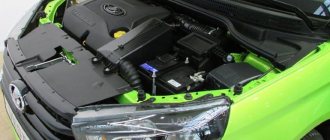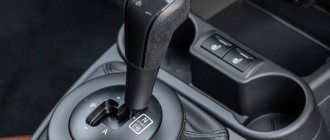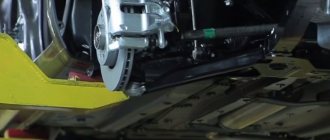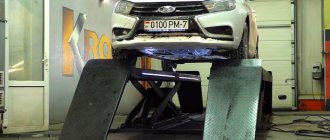Mileage Lada Vesta
Problems with high mileage cars
On Russian roads you can already find a Lada Vesta with a mileage of 100,000 km. Over a long period of driving, certain problems will certainly appear, and the need for minimal maintenance will arise. Based on reviews from Vesta owners, we can draw conclusions about its typical problems and general condition at different stages of operation.
It is clear that two cars with the same mileage may have different conditions. It depends on the driving conditions (city or highway) and the quality of the road surface. And it’s difficult to say exactly at what mileage this or that breakdown appears - everything wears out differently. So the problems listed below will not necessarily arise on your car.
Gearbox
Closer to 15,000 km, problems with the manual transmission may occur: extraneous sounds and sticking gears.
The “robot” Lada Vesta, which is called one of the main disadvantages of this car, does not perform well during operation. This includes noise, delayed gear shifting, and even gearbox failure.
On a note!
Some motorists notice that sometimes the shortcomings of the Lada Vesta gearbox disappear after changing the oil filled at the factory.
Mileage Lada Vesta
Minor errors
Possible breakdowns on the Lada Vesta It should be remembered that prices for Lada Vesta auto parts have different prices in dealerships. All components are purchased to order. You need to wait about a month for the purchase to arrive.
- The wheel caps have loose fastenings, so they constantly get lost when driving on gravel. During the tests, the antenna on the roof of the car also fell off.
- There are problems with the turn indicators in the side mirrors. They constantly fog up.
As a result, about 67,000 rubles were spent on repair work. Expert opinion informs all those interested that Lada Vesta performed very well during the run. In addition, the model provided was one of the first to be released from the factory, so we can refer to shortcomings in the initial assembly.
Body
In most cases, Lada Vesta owners have no complaints about the quality of the paintwork, much less the protection of body elements from corrosion. But some of its parts may still not withstand the influence of the external environment, namely:
- Roof, because it has the least protection against rust.
- Front bumper paint that is chipped off by gravel. Fortunately, this element is made of plastic and is not subject to corrosion, but its peeling appearance clearly does not decorate it. The rear bumper coating at the points of contact with the trunk lid also wears out quickly.
Problems with high mileage of a car Rust may appear on metal parts in the engine compartment, because... Due to the loose fit of the hood lid, a lot of dirt and moisture gets there.
Important!
To avoid serious system breakdowns, undergo timely maintenance of your Lada Vesta. Specialists will replace fluids and check the wear of car parts.
Lada Vesta reviews from owners with high mileage
Since November 2015, when the Lada Vesta came out, we already have our car-brother, who can share his impressions not only of its appearance, but also of its qualities such as cross-country ability, maintainability and its other positive and negative properties.
In general, all the useful things that can be gleaned from reviews of owners with high mileage cars.
This review contains reviews from those who post comments on forums, telling where, what knocked, creaked, crumbled, or came off. For example, some may have it after a year of use, and some may have it after a longer period. [divider] Oleg. 35 years. Samara
1.8 Luxe Prestige AMT
I purchased Vesta in December 2015. In a luxury package. 122 horsepower engine paired with an automatic transmission. Gave away 660 thousand wooden ones. The speedometer now shows 60 thousand. Overall assessment – it’s a good car, although not without its flaws.
As for repairs, at 55 thousand mileage the most serious thing that had to be repaired was replacing the bushings on the stabilizer. The car is nimble and the dynamics are fine, it holds the road well even in winter and wet conditions.
As for consumption, it is also quite acceptable for me - from 8 to 10 liters in combined mode, even if you don’t drive the horses. There is nothing to complain about with the technology, and the devices do not act up, they work well. All control and management options are in the subject.
One thing is confusing, but as they say, it’s not visible from the outside and doesn’t affect the speed, and maybe he’s too picky, that the trunk seems to be roomy, but its door hinges are disproportionately large. I had to transport the bedside table a short distance, and the hinges scratched one of its sides. Yes, and at first there was a smell of plastic in the cabin, but then it either disappeared or I got used to the smell. As for the whistling and creaking, after replacing the stabilizer bushings, which creaked until the other crickets in the cabin and under the hood started up. There are complaints about the body, namely:
- The color on the bumpers and body is different:
- door seals are not of the best quality;
- After the first winter, signs of rust appeared on the door sills.
[divider]
Rest
Owner reviews also cover the following points:
- the durability of the standard jack leaves much to be desired - it fails even with infrequent use;
- sometimes scratches appear on the windows of the driver and passenger - all because of the velvet and sand accumulated there;
- with the onset of cold weather, many complain about weak windshield heating;
- crickets may occur in the cabin;
- wheel caps are often lost;
- The antenna mount breaks.
Some measurement results
| Types of measurements | Start of testing | End of testing |
| Maximum speed, km/h | 178,5 | 179,7 |
| Acceleration time, s | ||
| 0—50 km/h | 3,8 | 3,7 |
| 0—100 km/h | 11,3 | 11,2 |
| 0—150 km/h | 29,4 | 29,2 |
| on the way 400 m | 17,9 | 17,8 |
| on the way 1000 m | 33,1 | 33 |
| 60-100 km/h (III) | 7,8 | 7,4 |
| 60-100 km/h (IV) | 12,6 | 11,2 |
| 80-120 km/h (V) | 21,3 | 18,5 |
| Run-out, m | ||
| from 50 km/h | 765 | 752 |
| 130—80 km/h | 1006 | 1024 |
| 160—80 km/h | 1501 | 1523 |
| Braking from 100 km/h | ||
| path, m | 40,1 | 40 |
| deceleration, m/s² | 9,6 | 9,6 |
We also recommend reading similar life tests of Lada Xray
Owner review
The car had its first maintenance at the dealer. All subsequent further maintenance work on Vesta was carried out without reference to a dealer service station. The factory Rosneft motor oil was replaced by Total 5W-40 synthetic.
The engine never required special attention, the suspension and the chassis as a whole endured all the hardships. There are no problems with sound insulation or corrosion.
There were no unforeseen repairs, only maintenance and tire changes:
- 45,000 km - replacement of brake pads.
- 55,000 km - replacement of brake discs.
- up to 100 thousand km - the mechanism for adjusting the gaps in the rear brakes required thorough cleaning. It was also decided to replace the rear brake pads.
- up to 100 thousand km - polyurethane bushings replaced rubber stabilizer bushings.
- 99,000 km - the right front stabilizer mounting bracket is cracked. The malfunction was eliminated by welding the metal.
- about 100 thousand km - the timing drive mechanism and the cooling system pump were replaced.
- a year after purchase - replacement of plastic tubes that regulate the operation of the intake manifold. Factory ones are cracked.
Car diagnostics on a lift
Dry shock absorbers, “live” balls, intact boots, no-loose steering.
Notes:
- The exhaust system corrugation needs to be replaced.
- There are pockets of corrosion on the outside of the front of the rear wheel arches.
- Corrosion on gas tank mountings.
The car is well treated with anti-corrosion from the factory and does not require additional treatments for the first 2-3 years of operation. The only thing that needs to be lubricated is the gas tank mount.
Optics and glazing: all scratched
Headlights and lanterns for Vesta are not cheap. Defects on them are a reason for good bargaining. Headlights lose effectiveness over the years due to worn-out shades. It’s too arrogant to demand a discount on the price of new headlights, but for polishing it’s ok.
Turkish Sisecam glass is very soft and scratches easily. This applies to both wind and side winds. Abrasion on them is normal, so do not rush to suspect the owner of a twisted mileage.
Glass scratches quickly, and this, unfortunately, is the norm.
Glass scratches quickly, and this, unfortunately, is the norm.
Vesta's sores
- Wheel caps keep getting lost.
- The cover with the antenna fell off the roof of the car.
- The turn signals in the side mirrors fog up (see thread on the forum).
About spare parts
- Prices from official dealers are not the same, but may differ several times. For example, a set of front brake pads can cost from 1,500 to 3,800 rubles at different dealers.
- The most expensive spare part was the muffler - 11,000 rubles.
- Almost all spare parts for Vesta have to be purchased to order and wait on average 1 month.
Show/Hide text
| Costs for a Lada Vesta car | ||
| Mileage, km | What was spent on | Amount, rub. |
| 3500 | Wheel cap | 100 |
| 6375 | Brake pads | 2420 |
| 7930 | Exhaust system mounting support | 50 |
| 10020 | Exhaust system mounting support | 50 |
| 10020 | Brake pads | 1950 |
| 10100 | Wheel cap | 100 |
| 11790 | TO-1 (oil, oil filter) | 2800 |
| 12580 | Engine plastic cover retainer | 110 |
| 15850 | Brake pads | 1950 |
| 16260 | Wheel cap | 100 |
| 18320 | Exhaust pipe | 11300 |
| 20300 | Exhaust system mounting support | 50 |
| 23250 | Muffler suspension | 200 |
| 23750 | TO-2 (oil, oil, air, cabin filters, spark plugs) | 5500 |
| 25520 | Rear shock absorber | 3100 |
| 25600 | Antenna | 4500 |
| 26000 | Rear shock absorber | 3100 |
| 26800 | Rear suspension beam silent blocks | 1220 |
| 27600 | Brake pads | 1950 |
| 30300 | Wheel cap | 100 |
| 31200 | Wheel cap | 100 |
| 31500 | Heater radiator (complete with heater) | 19000 |
| 31800 | Release bearing | 4450 |
| 31800 | Secondary shaft bearing | 1450 |
| Topping up engine oil (for the entire period) | 320 | |
| Total for maintenance and repairs | 67920 | |
| other expenses | Tires (4 sets) | 44000 |
| Gasoline AI-95 (average consumption 12.3 l/100 km) | 145630 | |
| Total expenses | 257550 | |
Transmission, engine and its systems
- No breakdowns of the VAZ-21129 engine (1.6 l, 106 hp) were recorded during the entire period of endurance testing. The power unit was serviced according to technical regulations.
- The fastenings of the decorative engine cover broke several times (see How to modify the engine cover).
- A slight chafing of the hose by the plastic cover of the engine was noticed (see What to do if hoses/pipes under the hood chafe).
- The heater radiator leaked.
- The muffler burned out.
- All muffler cushions (gingerbread) were torn 2 times.
- After 15,000 kilometers, 1st, 2nd and 3rd gears began to resist and were difficult to engage (the rod blocking block was stuck in its hole). Towards the end of the tests, the manual gearbox from Renault (JH3) began to howl with bearings, and it had to be repaired.











